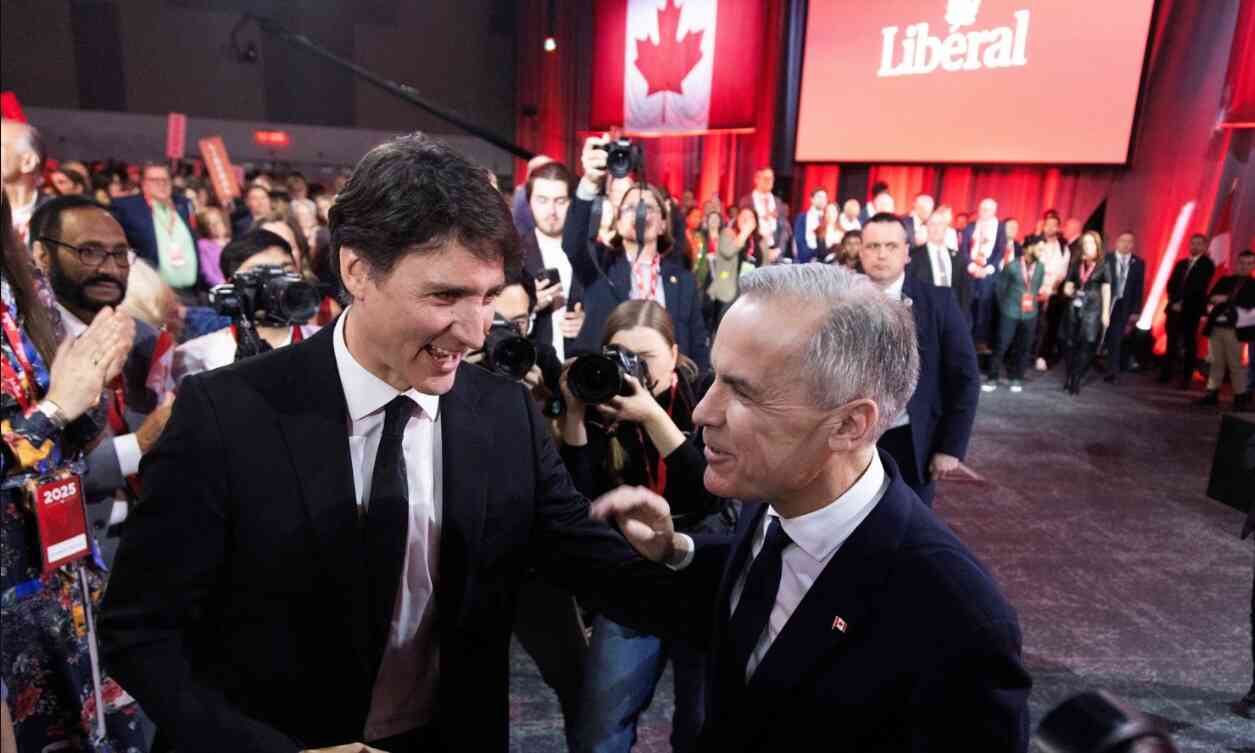Carney’s Surge Shocks Canada: Election Vortex Revealed
Polls Flip as Mark Carney’s Liberals Storm Ahead in Snap Election

On March 23, 2025, Canadian Prime Minister Mark Carney, barely weeks into his tenure, dropped a bombshell: a snap election set for April 28. The move, announced via a video on X, came as Carney, a former central banker with no prior elected office, replaced Justin Trudeau as Liberal Party leader. Polls at the time showed a tight race, but as of April 25, Carney’s Liberals have surged to a commanding lead over Pierre Poilievre’s Conservatives, with 42.4% to 38.5% according to CBC’s Poll Tracker. This dramatic shift, fueled by U.S.-Canada tensions and a wave of patriotism, has turned Canada’s political landscape upside down.
From Underdog to Frontrunner
Just months ago, the Conservatives held a near-unassailable edge. In 2023, CBC’s polling aggregator pegged their chance of victory at 99%, a lead they maintained until mid-February 2025. Poilievre, often likened to Donald Trump for his populist rhetoric, seemed poised to end the Liberals’ decade-long grip on power. But Trudeau’s resignation, Trump’s trade war threats, and Carney’s rapid ascent as a steady-handed technocrat flipped the script. By April 6, Ipsos reported the Liberals at 46%, a double-digit lead over the Conservatives’ 34%. Even as the gap narrowed to 5 points by April 21, Carney’s momentum held firm.
The Trump Factor: A Game-Changer
U.S. President Donald Trump’s shadow looms large over this election. His 25% tariffs on Canadian imports and 10% duties on energy, imposed in early 2025, sparked outrage across Canada. Trump’s repeated quips about making Canada the “51st state” during a March 28 call with Carney—confirmed by the prime minister on April 24—ignited a patriotic backlash. “There will always be a Canada,” Carney declared on X, a statement that resonated with voters. Polls show 46% of Canadians trust Carney to manage U.S. relations, compared to 28% for Poilievre, per Leger’s April 14 survey. The trade war, projected to halve Canada’s economic growth this year according to the OECD, has made Carney’s financial expertise a key asset.
Carney’s Blitz: Campaigning at Warp Speed
Carney, running for MP in Nepean, a southern Ottawa suburb, has campaigned relentlessly. On April 22, he rallied supporters in Laval, Quebec, vowing to “win the trade war” against Trump. By April 23, he was in British Columbia’s White Rock Promenade, mobbed by crowds in a drone-captured spectacle reported by Reuters. His message: stability in chaos. “We are facing the biggest crisis of our lifetimes,” Carney said at a Montreal debate, framing himself as Canada’s bulwark against Trump’s economic aggression. His approval rating, at 48% per Ipsos, dwarfs Poilievre’s.
Poilievre’s Fight: Gaining Steam on Affordability
Despite the Liberal surge, Poilievre isn’t down for the count. Ipsos’ April 17-19 poll shows him edging out Carney on affordability (+4 points) and tying on keeping election promises. In Saskatoon and Vancouver Island on April 25, Poilievre pitched his “fortress” plan to shield Canada from U.S. trade blows, promising $2.6 billion in economic defenses. His campaign signs face off against Carney’s in rural Ottawa, a literal dividing line captured by The Guardian. Yet, with only 38% support in Leger’s April 14 poll, Poilievre struggles to regain his once-dominant lead.

Regional Battlegrounds: Where Votes Matter Most
Ontario and Quebec, home to the majority of Canada’s 343 electoral seats, are Carney’s strongholds. The Liberals lead in both, with 66% support in Atlantic Canada per Narrative Research’s April 24 poll. British Columbia’s 43 districts remain a toss-up, with Reuters noting fierce competition. Toronto and the Greater Toronto Area (GTA), with 55 ridings and 4.5 million voters, are critical. CBC News reported on April 25 that Milton East—Halton Hills South, visited by both leaders, is a bellwether. Advance polls, closing April 19, saw a record 7.3 million Canadians vote, signaling high engagement.
What It Means Now
Carney’s lead, projected to secure 186 seats per 388 Canada’s April 24 forecast, points to a Liberal majority, surpassing the 172 seats needed. This would mark a historic comeback, defying two years of Conservative dominance. For Canadians, it means a government focused on counter-tariffs and economic resilience, with Carney promising to funnel tariff revenue to affected businesses. For U.S.-Canada relations, a Carney victory could escalate trade tensions, as he’s vowed to maintain retaliatory levies. Poilievre’s potential upset, though less likely, would shift Canada toward deregulation and tax cuts, possibly aligning closer to Trump’s agenda. The election’s outcome will shape Canada’s sovereignty and economy for years.
The X Buzz: Voices from the Ground
Verified X accounts reflect the election’s heat. @CBCNews posted on April 25: “Carney’s Liberals lead in Toronto, GTA ridings—key to victory.” @Reuters shared drone footage of Carney’s B.C. rally, captioned: “PM Carney draws crowds in battleground British Columbia.” Witnesses in Winnipeg, quoted by CBC, said Carney’s April 24 rally at Pyramid Cabaret felt “electric,” with supporters chanting “Canada first.” Poilievre’s Saskatoon event drew similar passion, with attendees telling CBC they want “a fighter for the middle class.” These snapshots, echoed across X, show a nation polarized yet energized.
The Polls: A Rollercoaster Ride
Polls tell a story of upheaval. In February, @338Canada reported a dead heat at 37% for both parties with Carney as Liberal leader. By April 13, @SpencerHakimian noted betting markets favoring Carney 3-to-1. Polymarket’s April 23 data gave Carney an 80.5% chance of staying prime minister, up from 77% days earlier. Yet, a Mainstreet Research poll on April 14, cited by @KatKanada_TM, briefly showed Poilievre ahead 44.3% to 42.3%. CBC’s April 25 tracker, aggregating polls from Léger, Ipsos, and Mainstreet, confirms the Liberals’ 5-point edge. This volatility underscores the election’s unpredictability.
Global Eyes on Canada
The world is watching. Sky News called the election a “contest turned on its head by Trump,” while The Economist’s April 23 model gave Carney an 86% chance of winning the most seats. Bloomberg reported on April 24 that Canadian business leaders trust Carney to counter Trump, citing his Goldman Sachs and Bank of England pedigree. The Guardian warned that a Liberal win would be “the largest political comeback in Canada’s history.” With global trade and sovereignty at stake, this election transcends borders.
The Final Sprint
With just two days until April 28, Carney and Poilievre are in overdrive. Carney’s Winnipeg rally on April 24 saw him pledge to scrap the consumer carbon tax, a pragmatic pivot from Trudeau’s policies. Poilievre, in Vancouver Island, doubled down on affordability, promising tax relief for working families. Both leaders will face off in Toronto on April 26, targeting undecided voters in the GTA. Elections Canada reports 343 ridings in play, with 172 needed for a majority. The race, once Poilievre’s to lose, now hinges on Carney’s ability to hold his lead.
A Nation at a Crossroads
Canada stands at a pivotal moment. Carney’s rise, fueled by economic fears and national pride, has defied expectations. Poilievre’s resilience keeps the Conservatives in contention, especially among voters hit hard by inflation. The April 28 election will decide not just Canada’s next government but its stance against a turbulent global backdrop. As 7.3 million advance voters and millions more prepare to cast ballots, the world holds its breath. Stay sharp with Ongoing Now 24.






Hi,
If you’re looking to grow your search traffic, you need an ongoing SEO strategy.
At Hilkom Digital, we focus on long-term growth through tailored SEO strategies, including advanced Answer Engine Optimization (AEO). AEO ensures your content is optimized specifically for AI-driven search platforms and featured snippets, significantly increasing your online visibility.
Our monthly plans are built for performance and designed for businesses that want impactful ROI — not just vanity metrics.
Due to strong client interest and our commitment to quality, we can only work with a limited number of clients each month. This ensures we maintain quality service for every client.
______________
What’s Included:
* On-site SEO & technical optimization
* High-authority link building
* Smart keyword focus and tracking
* Toxic link cleanup & disavow file handling
* Accelerated indexing to boost visibility
* Advanced AEO strategies for AI-driven searches
* International SEO options
______________
Availability is tight — secure your monthly SEO plan now: https://www.hilkom-digital.com/seo-services/
Need more info? Chat with an SEO expert here: https://www.hilkom-digital.com/whatsapp-us/
Let’s scale your rankings, increase your reach, and build your success — the smart way.
Best regards,
Mike Michel David
Hilkom Digital Phone/WhatsApp:
+1 (855) 221-7591
support@hilkom-digital.com